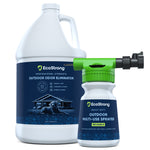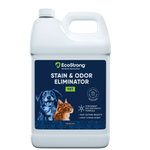Septic systems are crucial for waste management in many homes, but when they fail, it can lead to significant issues. Understanding how to identify and address these problems promptly is essential to avoid further complications and expenses. In this guide, we will walk you through the common signs of septic system failure, the reasons behind these failures, and detailed steps to fix the issues, highlighting the effectiveness of EcoStrong's Septic Liberator in restoring your system's functionality.
Understanding Septic System Failure
Common Signs of a Failing Septic System
Recognizing the symptoms of a failing septic system early can prevent more severe damage. Look out for the following signs:
- Slow Drains: If sinks, showers, and toilets are draining slower than usual, it might indicate a blockage in the system.
- Sewage Backup: This is a clear sign of a serious issue. If wastewater is backing up into your home, immediate action is needed.
- Foul Odors: Persistent bad smells around your property, especially near the drain field, suggest that your septic system is not functioning properly.
- Lush Patches in the Yard: Unusually green or lush patches of grass over the drain field can indicate that wastewater is surfacing.
- Pooling Water: Standing water or wet areas around the septic tank or drain field is a strong indicator of system failure.


Causes of Septic System Failure
Several factors can contribute to the failure of a septic system:
- Lack of Maintenance: Regular pumping and inspections are crucial. Neglecting these can lead to system overload.
- Overloading the System: Excessive water usage can overwhelm the septic system, leading to backups and failures.
- Physical Damage: Tree roots, heavy machinery, or construction work can damage the septic tank or pipes.
- Flushing Non-biodegradable Items: Items like wipes, diapers, and feminine hygiene products can clog the system.
Steps to Fix a Failing Septic System
1. Inspect and Diagnose the Problem
Before taking any action, it’s essential to identify the root cause of the failure. If you have noticed the signs of a failing septic system above you're ready to use Septic Liberator. A professional inspection can also determine whether the issue lies with the septic tank, the drain field, or the plumbing system. They will check for blockages, leaks, and overall system health. Before spending thousands on costly septic repairs you can use Septic Liberator to naturally solve the issues.
2. Use EcoStrong's Septic Liberator
EcoStrong's Septic Liberator is an effective solution for breaking down organic matter and restoring the natural bacterial balance in your septic system. Here’s how to use it:
- Application: Pour the recommended amount of Septic Liberator into your toilet or directly into the septic tank. The closer to the tank the better! You can also put it down toilets and drains.
- Action: The product works by introducing powerful enzymes and bacteria that digest organic waste, reducing sludge and preventing clogs.
- Maintenance: Regular use of Septic Treatment Pods can help maintain the efficiency of your septic system, preventing future failures.
-


3. Schedule Your Next Pump
One of the next steps in fixing a failing septic system is to schedule your next pump of the tank. You want to schedule your next pump 6 months after using a septic shock treatment like Septic Liberator. You need to let the natural bacteria in Septic Liberator to eat and dissolve waste for at least a month before pumping. Pumping your septic tank removes the solid waste and allows the system to function more effectively. Regular pumping is necessary to maintain the health of your septic system.
4. Clean the Septic Tank and Drain Field
Over time, sludge and debris can build up in the septic tank and drain field, causing blockages. Cleaning these components is crucial to restore proper function. EcoStong's Septic Liberator will breakdown sludge and waste build up.
5. Repair or Replace Damaged Components
If the inspection reveals physical damage, such as cracked pipes or a compromised tank, repairs or replacements will be necessary. Consult with a septic system professional to determine the best course of action.
6. Improve Water Efficiency
Reducing water usage can alleviate stress on your septic system. Fix leaks, install water-efficient fixtures, and spread out laundry loads to prevent overloading the system.
7. Avoid Harmful Chemicals
Harsh chemicals can kill the beneficial bacteria in your septic system. Avoid using bleach, antibacterial soaps, and other chemical cleaners that can disrupt the natural balance of your system.
8. Monitor and Maintain Regularly
Regular maintenance is key to preventing septic system failure. Schedule routine inspections, pump the tank as needed, and use EcoStrong's Septic Treatment Pods monthly to keep your system running smoothly.

Frequently Asked Questions
How often should I pump my septic tank? Septic tanks should typically be pumped every 3-5 years, depending on the size of the tank and the number of people in the household. Alternative systems with electrical float switches, pumps, or mechanical components should be inspected more often, generally once a year.
Can I use bleach with a septic system? It's best to avoid bleach and other harsh chemicals, as they can kill the beneficial bacteria that break down waste in your septic system.
What should I do if my septic system smells? Persistent odors can indicate a problem with your septic system. Use EcoStrong's Septic Liberator as your first line of defense for odors & septic shock treatment. Then if the problem persists schedule an inspection to identify and address the issue.
How does EcoStrong's Septic Liberator work? EcoStrong's Septic Liberator uses powerful enzymes and bacteria to break down organic waste, reducing sludge and preventing clogs. Regular use every 6 months helps maintain a healthy septic system.
Can tree roots damage my septic system? Yes, tree roots can infiltrate and damage septic pipes and tanks. It's important to keep large trees away from your septic system.
What is the best way to prevent septic system failure? Regular maintenance, including pumping, inspections, and using products like EcoStrong's Septic Liberator, can help prevent septic system failure.
Addressing a failing septic system promptly is crucial to prevent further damage and costly repairs. By understanding the signs of failure, the causes, and the steps to fix the issues, you can maintain a healthy septic system. EcoStrong's Septic Liberator is an effective solution that aids in breaking down organic waste and maintaining system efficiency. Regular maintenance, mindful water usage, and avoiding harmful chemicals will help keep your septic system functioning optimally for years to come.

















